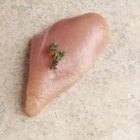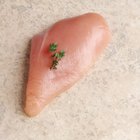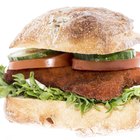
Electric skillets cook boneless chicken breasts much the same as a conventional skillet on the stove top, but the electric frying pan can better regulate the desired temperature and prevent overcooking. On the stove top, the skillet might be at the correct temperature when you add the chicken, but the pan can continue to heat up, which can burn the outside of the chicken breast before the inside cooks through. Rather than guessing at the temperature with vague settings such as "medium" or "medium-high," electric skillets allow you to set an exact cooking temperature, much like the temperature controls for your oven.
Step 1
Place the electric skillet on a level surface clear of anything that could be damaged from the heat. Turn the dial near the cord to preheat the skillet to between 325 degrees Fahrenheit and 350 F.
Step 2
Add oil to the skillet as needed to prevent the chicken from sticking. Electric skillets with non-stick surfaces require little to no oil at all, but some skillets require a generous coating of oil.
Step 3
Season the chicken breast with your choice of seasonings and spices. If desired, place the chicken between two sheets of plastic wrap and pound it to an even thickness with a meat mallet so the chicken cooks evenly and faster. Chicken breast is naturally thick at one end and tapers to a thin point; the tapered end is done and dries out before the thicker end if you don't first flatten the breast.
Step 4
Place the chicken breast in the skillet with the flatter side facing down. This is the side that was cut to remove the breast from the chicken while the other side is smooth and rounded. Cook the chicken, covered, for about 10 to 12 minutes; the chicken should develop a golden-brown color. While you don't need to flip the chicken constantly, it helps to move it around the pan to prevent sticking.
Step 5
Flip the chicken breast over with a pair of tongs and cook the other side for another 10 to 12 minutes or until the internal temperature reaches a minimum of 165 F. Insert a meat thermometer into the thickest part of the breast. Exact cooking times vary greatly depending on the size and thickness of the breast, so a meat thermometer is the best way to determine when the breast is done. For example, if you pound the chicken breast into a thin cutlet before cooking, it will cook much faster than a breast left in its original shape.
Related Articles

How to Cook a Thin Breaded Chicken ...

How to Cook Sauteed Chicken With White ...

How to Preserve Chicken

How to Cook Chicken Schnitzel

How to Bake Boneless Chicken to Stay ...

How to Make Crock-pot Chicken

How Long Do You Need to Boil Large ...

How to Cook a Flat Chicken

How to Broil Chicken on the Bone

How to Bake Chicken Breast Without Oil

How to Make Blackened Chicken

How to Cook Chicken Kebabs in a Bottom ...

How Do I Make Baked Boneless Chicken ...

How to Cook Chicken Bratwurst

Can I Stop Cooking a Chicken Halfway & ...

How to Slow Cook Chicken With Tomatoes ...

Easy Way to Cook Chicken Breasts for ...
Quick and Easy Chicken Parmesan Recipe

How to Defrost a Chicken in a ...

How to Re-Crisp a Cold Roast Chicken
References
- Foodsafety.gov: Safe Minimum Cooking Temperatures
- Presto: 16-inch Electric Skillet With Glass Cover Instructions
- The Kitchn: What Does an Electric Skillet Do Best?
- Rival: Electric Skillet Owner's Guide
- Oregon State University Library: Choosing and Using an Electric Skillet
- The Kitchn: How To Cook Moist and Tender Chicken Breasts Every Time
Tips
- Boneless chicken breasts cook much faster than bone-in chicken breasts -- bone-in breasts can take as long as 40 minutes to cook through.
- Unlike many beef and pork meat cuts, chicken doesn't require a resting period for redistributing the juices. However, it's important to remove the breasts immediately when they reach 165 F so the meat doesn't dry out and lose its flavor.
Writer Bio
A former cake decorator and competitive horticulturist, Amelia Allonsy is most at home in the kitchen or with her hands in the dirt. She received her Bachelor's degree from West Virginia University. Her work has been published in the San Francisco Chronicle and on other websites.
Photo Credits
Polka Dot Images/Polka Dot/Getty Images